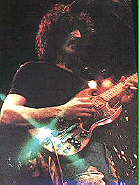ZAPPA AND HIS GUITARS 
ALTHOUGH HE WAS ALWAYS CRITICAL OF HIS PLAYING ABILITIES; FRANK ZAPPA
WAS ONE
OF THE ELECTRIC GUITAR'S MOST ORIGINAL STYLISTS. MANY OF HIS RECORDINGS
FEATURE
EXTENDED GUITAR EXCURSIONS THAT DISPLAY HIS UNIQUE LEGATO PHRASING;
HORN LIKE DISTORTED TONE; AND COMPLEX SENSE OF RHYTHM. HE WAS ALSO A BRILLIANT
COMPOSER WHO PURSUED HIS MUSICAL VISION WITHOUT CONCEDING TO POPULAR TRENDS.
HIS SUCCESS, COUPLED WITH HIS COMMITMENT TO ARTISTIC EXCELLENCE; HAS PROVIDED
INSPIRATION AND MOTIVATION TO COUNTLESS MUSICIANS WORLDWIDE.
.
INFLUENCES
Frank's parents had a limited background in music. His father played guitar in college but never aspired to a professional music career. Zappa's first instrument was the drums he started playing drums when he was 12, and later took drum classes. By the time he was 15, he had acquired a drum set, and played in local bands. While he was still in high school, he enrolled in music-theory classes where he studied Walter piston's 'harmony' and started experimenting with 12 tone music.
Around the time that he turned 18, Zappa started collecting R&B records. The guitar solos that he heard on blues records inspired him to start playing the guitar: " The solos were never long enough, and I figured the only way I was going to get to hear enough of what I wanted to hear was to get an instrument and play it myself, " Zappa told Steve Rosen. Zappa says that he did not know any chords, but he learned to play single-note lines immediately. Later; he bought one of Mickey Baker's instructional books and learned how to play chords.
Zappa's primary guitar influences were blues guitarists. His favorites included Johnny guitar Watson, Clarence "gatemouth" Brown, Guitar Smith, Matt "guitar" Murphy, Hubert Sumlin, and B.B King. He particularly liked the solos on Watson's "three hours past midnight", Guitar Slim's "The story of my Life", Frankie Lee simms' "Lucy Mae Blues", and Elmore James "Happy Home". "I like all blues-type guitar players" he told Tom Mulhern in Guitar Player. " I happen to think that what they play really means something, as opposed to most of what happens on most rock 'n' roll records."

By the time he was 21, Zappa was gigging with R&B bands around San Diego. Later, he worked casual lounge jobs with a band called Joe Perrino And the Mellow Tones. Zappa was particularly disillusioned with playing in lounges." at the end of it I put my guitar in the case and stuck it behind the sofa and didn't touch it I guess for a year" he told Don Menn in Zappa.
" It was nauseating". He also listened to classical records while at
high school. Later he started writing chamber and orchestral music. He
was mainly interested in 20th-century composers, such as Pierre Boulez,
Stockhausen, Stravinsky, Edgard Varese, ans Anton Webern, whose non-traditional
uses of harmony, rhythm, and orchestration influenced many of his compositions.
He studied several classical music theory books, including Icolas Slonimsky's
Thesaurus Of Scales And Melodic patterns, which introduced him to new chords.
In the early 80's, he invited Slonimsky to perform on stage with him.
Several different ethnic music styles were also influential on Zappa's
music and playing. He particularly enjoyed the modal characteristics and
use of drones in Indian music. Other influences include Sardinian and Bulgarian
music, especially that of the Bulgarian Women's Choir.
He also appreciated a few Jazz and Rock musicians. One of his favorite Jazz albums was Wes Montgomery's The Montgomery Brothers. He enjoyed the music of Captain Beefheart and worked with him on several occasions. In various interviews he stated that he liked the playing of guitarists Allan Holdsworth, John McLaughlin, Jimi Hendrix, Jeff Beck, Eric Clapton with Cream, Brian May, Eddie Van Halen and Warren De Martini.